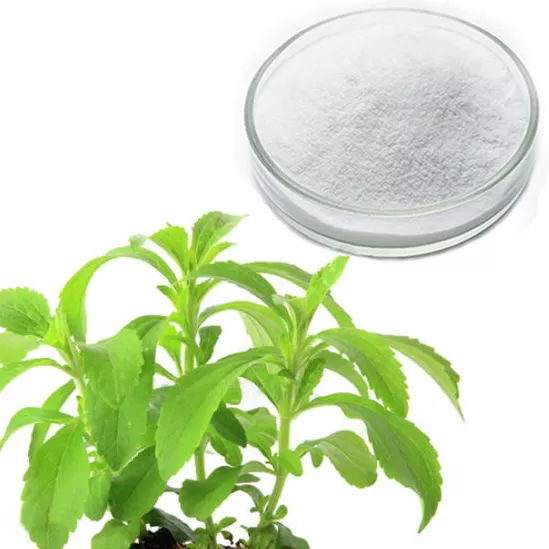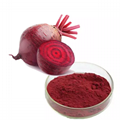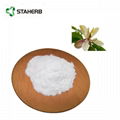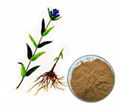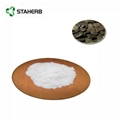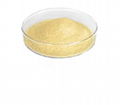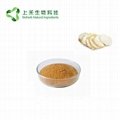| Model: | - |
|---|---|
| Brand: | Changsha Staherb |
| Origin: | - |
| Category: | Agriculture & Foods / Agricultural Products & Resources / Plant Extract |
| Label: | stevia extract , stevia extract , stevia extract |
| Price: |
-
|
| Min. Order: | - |
Product Description
Stevia (scientific name: Stevia rebaudiana (Bertoni) Hemsl.) is a perennial herb of the Asteraceae, Stevia genus. Plant height 1-1.3 meters. Root shoots are hypertrophic, 50-60, up to 25 cm long. Stem erect, base tip lignified, upper part tender, densely short hairs, corolla base light purple or white, upper part white. Achenes linear, slightly flat, brown, with pappus. The flowering period is July-September, and the fruiting period is September-November.
It is native to the alpine grasslands of the border between Paraguay and Brazil in South America. Since 1977, it has been introduced and cultivated in Beijing, Hebei, Shaanxi, Jiangsu, Anhui, Fujian, Hunan, Yunnan and other places in China.
This species likes to grow in warm and humid environments and is sensitive to light. The leaves contain 6-12% inulin, and the fine product is white powder. It is a natural sweetener with low calorie and high sweetness, and it is one of the raw materials for the food and pharmaceutical industries.
Chinese name: Stevia
Latin name: Stevia rebaudiana (Bertoni) Hemsl
Pest control
blight
Blight is a seedling disease.
Control methods: ①Choose well-drained and loose soil plots to raise seedlings; ②Use 50% carbendazim 2 kg/mu for soil treatment before sowing; ③Use 1000-1500 carbendazim spray or 500 carbendazim in the early stage of disease Water with double liquid; ④ Remove diseased plants in time, and use 3:1 mixed powder of plant ash and quicklime to treat diseased holes.
Leaf spot
The disease is prone to occur from July to October, damaging stems and leaves.
Prevention and control methods: ① Pay attention to drainage from May to June to reduce soil moisture, and apply more potassium fertilizer to improve plant disease resistance; ② Spray 50% carbendazim 1000 times liquid spray for control in the early stage of disease; ③ Clean the garden after harvest and dispose of residual strains, burnt centrally.
Leukemia
From April to May, there is more rainfall and the soil moisture is too high, which is often prone to this disease and damages the roots.
Prevention and control methods: 1. Reasonable dense planting, pay attention to ventilation and light transmission in the field; 2. Increase phosphorus and potassium fertilizers to avoid leggy growth of seedlings; 3. Once diseased plants are found, remove them immediately, and spray lime around the diseased holes for disinfection; The ward was irrigated with Ling 1000 times liquid to control the spread of the disease.
bridge worm
Also called inchworms or measuring worms, they mainly feed on leaves.
Prevention and control methods: It can protect the natural enemy of the inchworm, the velvet wasp, or spray it with 40% omethoate 1000 times dilution, and it is prohibited 20 days before harvest.
main value
edible
The main component in the dried leaves of Stevia is steviol glycosides, which not only has high sweetness and low calories, but also has certain pharmacological effects. Stevia mainly has the functions of treating diabetes, controlling blood sugar, lowering blood pressure, anti-tumor, anti-diarrhea, improving immunity, and promoting metabolism. It also has a significant effect on children's dental caries, and the most important thing is that it can eliminate the side effects of sucrose. The report of the Joint Expert Committee on Food Additives of the United Nations Food and Agriculture Organization and the World Health Organization clearly stated in the report of the 69th meeting in June 2008 that the normal daily intake of stevia is less than 4 mg/kg body weight and has no side effects on the human body. In South America, Southeast Asia, and the Far East, steviol glycosides are widely used in food and pharmaceutical fields. The Chinese Ministry of Health approved steviol glycosides as a natural sweetener for unlimited use in 1985, and approved steviol glycosides as a sweetener excipient for medicinal use in 1990.
It has been widely used as medicine and diet. Since 1990, China has approved stevia as an excipient for medicinal sweeteners. Steviol glycoside derivatives also have clinical effects such as lowering blood pressure, blood sugar, anti-tumor, improving diarrhea and improving human immunity. Stevia is generally used as a flavoring agent to correct the peculiar smell and strange taste of some medicines, and as an auxiliary material for tablets, pills, capsules, etc. Since stevioside is a non-sugar sweetener, it will not produce acid under the action of bacteria in the mouth when it is eaten, so the candy food made with it will not corrode teeth due to acid production, and can be used to prevent Tooth decay in children. Since stevioside is resistant to acid and alkali, and is heated at 100°C in the pH range of 4-10, its chemical structure will not change, and it will not produce glucose required by microorganisms. It is a non-fermentable substance and is often used for food preservation and Anti-mildew medicine. Stevioside is hardly metabolized in the human body, and does not generate too much heat after eating, so it is often used to make sweet foods for obese patients, stevia drinks or stevia candies for children, etc., to avoid obesity. Childhood obesity.
Feed: Stevia leaf residue is rich in trace elements and has comprehensive nutrients, such as amino acids, crude protein, crude fiber, crude fat and vitamins. It can also improve the quality of milk and meat for diseases such as loss of appetite, fatigue, slow growth, no estrus, diarrhea and poor respiratory tract. Studies have shown that the stevia stems are extracted and concentrated in activated water at 45-60°C to prepare livestock health drinks and breast lotions, or the dried stevia stems and leaves are crushed, boiled, concentrated and fermented with mineral water. Let livestock directly eat, and have good curative effect on the treatment of livestock diseases. The residue of stevia leaves is mixed into the feed and used to feed cows and sheep, which can increase the sweetness of milk, improve the quality of milk and the content of trace elements, amino acids and other substances in milk, and has a certain promotion effect on milk production. Adding 5% of stevia leaf residue to poultry feed can prevent poultry from diarrhea and diarrhea, regulate the digestive function of poultry, and improve the egg production rate. As a feed additive, stevia can also increase the appetite of livestock, racehorses and pets, treat their chronic diseases, and promote the growth of stunted piglets and broiler chickens.
Fertilizer: Stevia residue not only has a very high content of organic matter, but also contains a certain amount of minerals such as calcium and magnesium, which can be used as an organic fertilizer to improve and fertilize soil. In actual production, the decomposed stevia residue and the basic substrate are mixed in a certain proportion, and then the soil can be formulated into the soil suitable for the seedlings of vegetables and fruits such as cantaloupe, watermelon, citrus, and tomato. This seedling soil can not only promote the rapid growth and development of seedlings, increase the dry and fresh weight of seedlings, but also promote the early maturity of vegetables and fruits and increase their sweetness, and is a good seedling substrate. Adding the residue of stevia leaves to the culture material of cultivated fungi can not only meet the nutrient needs of edible fungi, but also meet the requirements of edible fungi for various trace elements, vitamins and air permeability. Good and high yield. Flammulina velutipes cultivated in soil containing stevia residues have a slightly sweet taste and unique flavor; cultivated white fungus grows both white and large.
Company Introduction
Address: Room 202, Building B8, Huanchuang Enterprise Square, Lugu Street, Yuelu District, Changsha City, Hunan Province
Website: http://www.staherb.cn/
Business scope: Biotechnology, research and development of plant extracts (can be used in the field of pharmaceutical and health products, cosmetics, feed additives and biological pesticide production and development)
Main products: Eucommia extract - chlorogenic acid (5%-98%), ursolic acid (25%-98%), corosolic acid (1%-98%), bitter amygdalin (50%-98%), epimedoside (10%-98%) and other standardized high-purity plant extracts.
If you wanna know more about us, please feel free to contact me at:
Whatsapp: +86 13548561509
Email: staherb18@staherb.cn
or you can send me online message if it's convenient for you.
We look forward to cooperating with you!
Member Information
| Changsha Staherb Natural Ingredients Co., Ltd., | |
|---|---|
| Country/Region: | Hu Nan - China |
| Business Nature: | Manufacturer |
| Phone: | 18975842720 |
| Contact: | Yoland (sales) |
| Last Online: | 07 Nov, 2024 |
Related Products of this Company
-
rosemary oil of carnosic oil
US $17.65
-
Beetroot extract powder Red beet root
-
Euryale Ferox Extract
-
Flax Seed Extract
-
magnolia bark extract honokiol
US $180
-
Gentiopicroside
-
Griffonia Seed Extract Powder 5-HTP
US $191
-
Chinese Wild Yam Extract Powder
-
Camptothecin acuminata extract
-
lion's mane mushroom extract 30%
US $45
